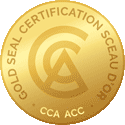
Fall Protection - British Columbia

Description
Why Choose Danatec's Fall Protection Training in BC?
Gold Seal Eligibility: This course is eligible for 1 Gold Seal Certification Credit from the Canadian Construction Association.
Interactive Learning: 3D-animated scenarios and real-world examples for an interactive experience.
B.C. Regulations: Everybody's legal responsibilities under WorkSafeBC (employers, supervisors, and workers) and best practices.
Practical Evaluation Tools: Offers useful evaluation tools and guides. Supervisors can use them to check workers' skills. They will learn to inspect equipment correctly, use fall protection systems effectively, and apply workplace safety measures confidently.
Useful Resources: Access a glossary and toolbox of resources for continued reference, promoting long-term safety awareness

Course Outline
Module 0: Getting Started
Establishing course structure, navigation, purpose, and assessment expectations. Introduces fall protection concepts, emphasizing the importance of safety training to reduce workplace injuries and fatalities.
Module 1: Introduction to Fall Protection
Learning the definition and importance of fall protection, legal requirements specific to BC workplaces, and stakeholder roles. Highlights worker rights, safety culture principles, and introduces fall protection plans.
Module 2: Fall Protection Systems
Details the different types of fall protection systems, including travel restraint, fall arrest, and fall restrict systems, plus equipment maintenance protocols. Explains the components of each system, their appropriate applications, and maintenance practices to ensure worker safety.
Module 3: Warning Methods and Physical Barriers
Focuses on preventive measures such as guardrails, bump lines, safety nets, and warning signs. Explains their installation requirements, usage scenarios, and effectiveness in preventing falls from heights.
Module 4: Work Access Equipment and Platforms
Explores the safe use of ladders, scaffolds, and mobile elevating work platforms (MEWPs). Discusses inspection requirements, fall protection integration, and the proper selection of equipment based on the task and work environment.
Module 5: Fall Hazards
Identifies common fall hazards such as unprotected edges and slippery surfaces. Includes strategies for hazard recognition, suspension trauma mitigation, and risk control measures.
Module 6: Hazard Management
Covers hazard assessments, the R.A.C.E method, and the hierarchy of controls for fall protection. Features detailed guidance on calculating fall clearance to ensure adequate safety measures, preventing workers from contacting the ground or obstacles in the event of a fall. Highlights the integration of fall protection plans into overall hazard management.
Module 7: Rescue Planning
Details the creation of fall rescue plans, including self-rescue, assisted rescue, and mechanical rescue methods. Explains suspension trauma risks, rescue equipment, and communication protocols for effective emergency responses.
British Columbia Jurisdictional Module
Focuses on British Columbia-specific regulations, including equipment standards, emergency preparedness, and hazard assessment. Provides direct references to applicable laws and best practices for fall protection in the province.
Final Exam & Certification
To successfully complete the training course, learners need a passing mark of 80% on the final exam. You have two attempts to pass will have up to two attempts to pass the exam. An industry-recognized digital certificate and wallet badge is issued immediately after passing. Certification is valid for three years.
Who Should Enrol?
Construction, industrial, and telecom crews working above ground level
Safety managers and site leads writing or auditing fall protection plans in B.C.
Maintenance techs and HVAC pros using lifts and ladders indoors or out
New workers getting certified for the first time, or veterans who need a refresher
Frequently Asked Questions
A self-paced online course aligned with WorkSafeBC regulations to equip workers with the skills and knowledge to prevent falls at heights.
How long is the Danatec fall protection course in BC?
Around 4 hours of learning, with flexible pacing.
Can I earn fall protection certification in BC online?
Yes — certificate is issued instantly upon completion and valid for three years
Does this course cover fall arrest training in BC?
Yes—it includes detailed fall arrest, travel restraint, and rescue modules.
What do I need to take it?
Any device with internet and a modern browser like Google Chrome. Headphones help for the videos.
What if I fail the test?
You get two tries. Most people pass the second time, especially with a quick review.
How do I renew?
Simply retake the course before your certificate expires every 3 years.
Need to certify the entire crew?
Danatec offers bulk enrolment, progress dashboards, automated renewal reminders, and dedicated account support. Call 1-800-465-3366 or email sales@danatec.com for details.